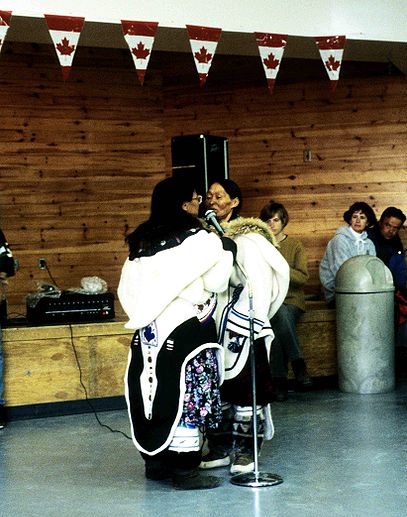Quick links
throat singing
DCHP-2 (May 2013)
Spelling variants:throat-singing
n. — Aboriginal (Inuit)
a type of singing performed by Inuit women (see Image 1).
Type: 4. Culturally Significant — The term is used in many English-speaking countries; however, outside of Canada, throat singing generally refers to a singing technique. In Canada, the term refers to a style of traditional singing performed by Inuit women (see, e.g. the 1987 and 2013 quotations), often by two women facing one another (see Image 1). Throat singing is particular to Inuit culture and associated with the Canadian North. The term is of national cultural importance (see, e.g., the 2013 quotation).
See also COD-2, s.v. "throat singing"(1), which is marked "Cdn".
See also COD-2, s.v. "throat singing"(1), which is marked "Cdn".
See: Inuit
Quotations
1977
Eschewing stars, night-time concerts and even advertising, Mariposa prefers to create a homey showcase for Newfoundland fiddling, New England yarns, Inuit throat singing and dozens of other unspectacular arts
1987
Inuit women in both Canada and Russia practice an ancient form of song, called throat singing, a rythmic, guttural singing that imitates the sounds of animals, singer Margarita Glukhikh, 50, said.
1997
Meanwhile, a Jan. 9 concert of works by Christos Hatzis at the University of Toronto's Walter Hall will feature music inspired by Inuit throat singing.
2008
Village residents filtered into the local community hall to exchange presents with the prime minister, perform traditional Inuit throat-singing, and to promise the prime minister a tiny slice of Arctic immortality.
2013
Cloutier began to teach herself throat singing at 18 and has since used that talent in a variety of settings - including performances with Toronto's Tafelmusik Baroque Orchestra in 2005 and 2007, the Belgian world-music group Think of One in 2004 and, in 2006, with Montreal's DJ Madeskimo.
While some people may get "nervous" about such mixtures - throat singing was originally done only by women, often at home at night as their children were falling asleep or their men were away hunting - Cloutier isn't one of them. "It's who we are as young Inuit today. I think I have a strong base in how I sing traditionally that allows me to feel confident in expressing myself and experimenting with it. It's like when you learn how to play piano from a teacher: You have a strong base, you can fly away on your own." At the same time, when singing a traditional throat song, Cloutier makes a point of not "mashing it up with something else ... I just want to honour the way it was taught to me."
References
- COD-2
Images
